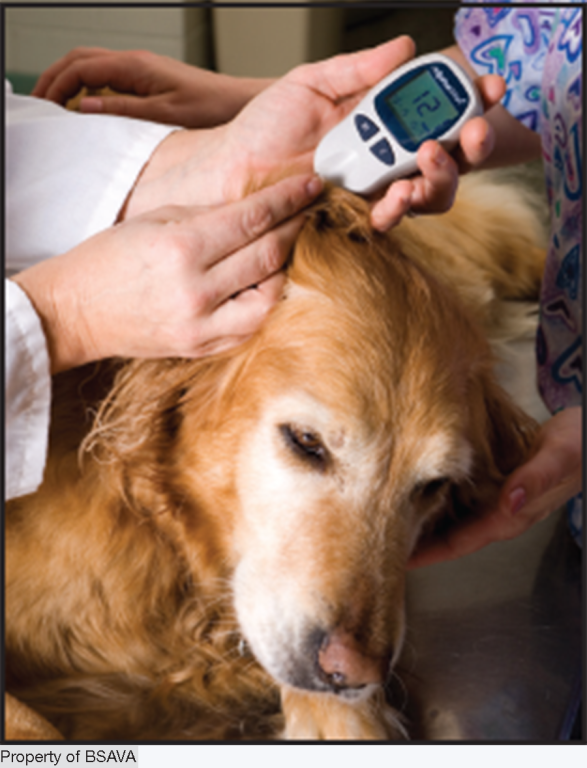
Dog having a blood glucose test
Comparing Vet-calibrated Portable Blood Glucose Monitors For Dogs
A new study, published in the latest issue of the Journal of Small Animal Practice (JSAP), compared both the AccuTell and AlphaTrak2 Portable Blood Glucose Monitors (PBGMs) against a reference method - the hexokinase reaction method. Although the accuracy of one of the most well-known veterinary PBGMs, the AlphaTrak, has been investigated, not enough is known about the accuracy of such monitors and standards have not yet been designed for veterinary PBGMs.
In the study “Comparative accuracy of two veterinary-calibrated point-of-care glucometres for measurement of blood glucose concentration in dogs” blood was sampled from client and staff-owned dogs above 6 months of age, of various breeds and health status. This was the first study to investigate AccuTell and the first published evidence comparing AlphaTrak2 with a reference method. The study aimed to determine the accuracy of both veterinary-calibrated PBGMs as well as how useful they are in clinical decision making and to assess the effect that packed cell volume (PCV) (known to affect the reliability of blood glucose concentration measurement in dogs) has on blood glucose concentration using the two PBGMs.
AccuTell was found to be more accurate and useful in a clinical setting than AlphaTrak2. Both PBGMs were inaccurate in comparison with the hexokinase reaction method, and although they have potential for standard clinical use, unexpected blood glucose concentrations need to be checked by the hexokinase reaction method. In addition, measurement of blood glucose concentration by the AlphaTrak2 was affected by PCV whereas measurement by the AccuTell was not.
Nicola Di Girolamo, Editor of JSAP concluded: “We oftentimes think that an instrument that is developed specifically for our patients will provide satisfactorily results on most occasions. Instead, studies such as the one presented here, are critical to understand whether the ‘numbers’ provided by an instrument are reliable for clinical use. The authors provided 95% limits of agreements to their results. This value is of great help for clinicians, since it shows the difference expected between the instrument and the reference standard in the majority of occasions.”
The full article can be found in the July issue of the Journal of Small Animal Practice and can be read online here: https://onlinelibrary.wiley.com/doi/epdf/10.1111/jsap.13491
1 Wolfenden, G, James, FE, Hung, LHT, Bruce, M, and Thompson, M (2022) Comparative accuracy of two veterinary-calibrated point-of-care glucometres for measurement of blood glucose concentration in dogs Journal of Small Animal Practice, Available at: https://onlinelibrary.wiley.com/doi/epdf/10.1111/jsap.13491
More from BSAVA
- Veterinarians are frequently prescribing metronidazole in contradiction to antimicrobial use guidelines, new study finds
- BSAVA to champion clinical research at BVA Live 2026
- Nominations open for the 2026 BSAVA Awards
- BSAVA PetSavers awards funding for eight new clinical research grants
- BSAVA launches Rover: A groundbreaking AI tool for veterinary professionals

 3 years ago
3 years ago  1593 views
1593 views
